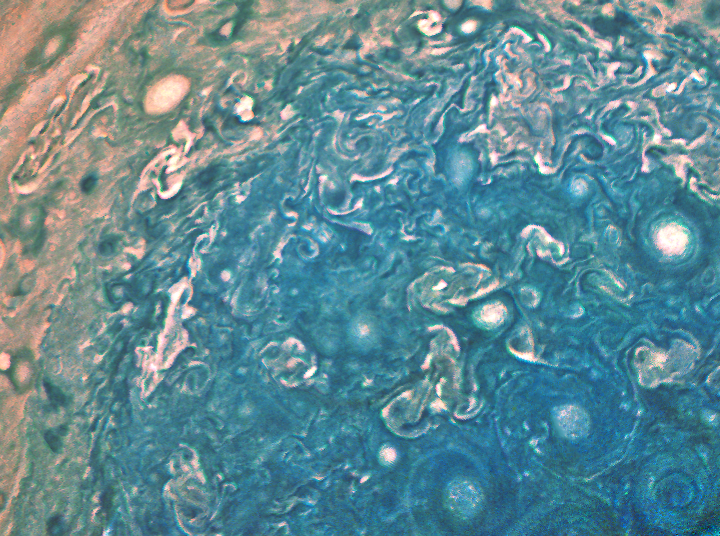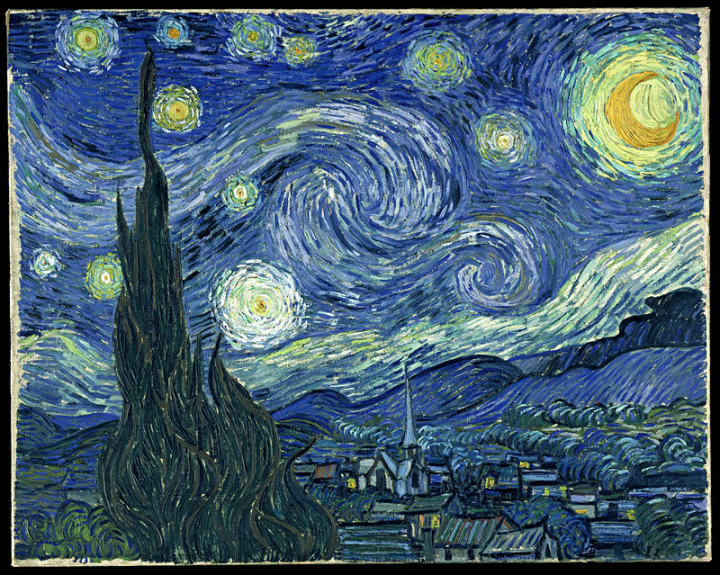At Jupiter reality imitates art

NASA this week released images taken by Juno during its fourth close fly-by of Jupiter on February 2. The image highlighted by that press release focused on a wide lightly processed view of the south pole, different from the image above. As the release states,
Prior to the Feb. 2 flyby, the public was invited to vote for their favorite points of interest in the Jovian atmosphere for JunoCam to image. The point of interest captured here was titled “Jovian Antarctica” by a member of the public, in reference to Earth’s Antarctica.
The image above, cropped and reduced here, was more heavily processed by another member of the public, and shows more clearly the mad, chaotic storms at the south pole.
What instantly struck me when I saw this however was how much it reminded me of this piece of art, painted in 1889 in France by a man who was slowly going insane.

Vincent Van Gogh never saw the storms on Jupiter, but his imagination conceived their existence in paint. Juno has now imaged them in reality.
On Christmas Eve 1968 three Americans became the first humans to visit another world. What they did to celebrate was unexpected and profound, and will be remembered throughout all human history. Genesis: the Story of Apollo 8, Robert Zimmerman's classic history of humanity's first journey to another world, tells that story, and it is now available as both an ebook and an audiobook, both with a foreword by Valerie Anders and a new introduction by Robert Zimmerman.
The print edition can be purchased at Amazon or from any other book seller. If you want an autographed copy the price is $60 for the hardback and $45 for the paperback, plus $8 shipping for each. Go here for purchasing details. The ebook is available everywhere for $5.99 (before discount) at amazon, or direct from my ebook publisher, ebookit. If you buy it from ebookit you don't support the big tech companies and the author gets a bigger cut much sooner.
The audiobook is also available at all these vendors, and is also free with a 30-day trial membership to Audible.
"Not simply about one mission, [Genesis] is also the history of America's quest for the moon... Zimmerman has done a masterful job of tying disparate events together into a solid account of one of America's greatest human triumphs."--San Antonio Express-News

NASA this week released images taken by Juno during its fourth close fly-by of Jupiter on February 2. The image highlighted by that press release focused on a wide lightly processed view of the south pole, different from the image above. As the release states,
Prior to the Feb. 2 flyby, the public was invited to vote for their favorite points of interest in the Jovian atmosphere for JunoCam to image. The point of interest captured here was titled “Jovian Antarctica” by a member of the public, in reference to Earth’s Antarctica.
The image above, cropped and reduced here, was more heavily processed by another member of the public, and shows more clearly the mad, chaotic storms at the south pole.
What instantly struck me when I saw this however was how much it reminded me of this piece of art, painted in 1889 in France by a man who was slowly going insane.

Vincent Van Gogh never saw the storms on Jupiter, but his imagination conceived their existence in paint. Juno has now imaged them in reality.
On Christmas Eve 1968 three Americans became the first humans to visit another world. What they did to celebrate was unexpected and profound, and will be remembered throughout all human history. Genesis: the Story of Apollo 8, Robert Zimmerman's classic history of humanity's first journey to another world, tells that story, and it is now available as both an ebook and an audiobook, both with a foreword by Valerie Anders and a new introduction by Robert Zimmerman.
The print edition can be purchased at Amazon or from any other book seller. If you want an autographed copy the price is $60 for the hardback and $45 for the paperback, plus $8 shipping for each. Go here for purchasing details. The ebook is available everywhere for $5.99 (before discount) at amazon, or direct from my ebook publisher, ebookit. If you buy it from ebookit you don't support the big tech companies and the author gets a bigger cut much sooner.
The audiobook is also available at all these vendors, and is also free with a 30-day trial membership to Audible.
"Not simply about one mission, [Genesis] is also the history of America's quest for the moon... Zimmerman has done a masterful job of tying disparate events together into a solid account of one of America's greatest human triumphs."--San Antonio Express-News


I can’t resist…
Don McLean
“Vincent”
BBC 1972
https://youtu.be/AVprz0nm0Y4
(4:03)
BBC video above, is live-in-studio.
This version is audio with pictures of all of Van Gogh’s artwork.
Don McLean
“Vincent”
https://youtu.be/KLvzF981Fiw
(5:34)
You beat me to it, wayne.
Great song about a great painter. I once made it to the Art Institute of Chicago to see Seurat’s “A Sunday on La Grande Jatte” and in the same Helen Birch Bartlett collection was Van Gogh’s Bedrooms at Arles. Remarkable.
eddie willers–
Good deal!
-Seurat did the pointillism, correct?
American Illustrator Virgil Finlay had a similar style.
http://www.isfdb.org/cgi-bin/ea.cgi?1084
I wonder if those clouds would even be visible if one were close. An interstellar nebula is so thin that it becomes invisible when one is inside of it, the nearby Gum nebula actually takes up 40 degrees of the sky but we cannot see it. Jupiter’s atmosphere consists almost only out of hydrogen and helium, and then nitrogen, oxygen and noble gasses which are also invisible to the naked eye. Only tiny traces of carbon and oxygen which as CO and CO2 and CH4 is invisible along with ammonia, hydrogen sulfide and phosphane. All colorless gasses.
I wonder what it is we really see in those images. I suppose it’s ices and aerosols. While water does have a bluish taint, it is very weak, but we do see white clouds that are much thinner than the ocean. Water clouds are just white or gray, unless rarely sunlight makes them reddish. Jupiter’s sky could be a firework, or thin as air.